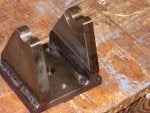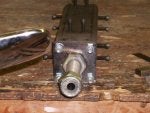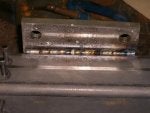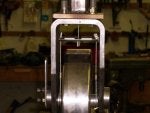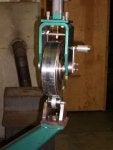The lower tool arm was made by sawing a taper into a piece of the 3x5 tubing.
The upper yoke is from an offcut of 4x8 square tube. I milled it out to create flats for the eccentrics to run on. The eccentrics are for the quick release on the upper wheel. I made the eccentrics on the lathe and mill, fairly simple just 2 large dia pieces of round stock machined to fit holes precision bored into each side of the yoke. These pieces then get bored out for the axle, a piece of 22mm stock, or in this case a piece of 1" stainless that I turned down to 22mm. The holes for the 22mm stock were bored in 1/4" off centre, this gives a 1/2" lift on the wheel.
The yoke indexes at 90 degress as does the lower anvil holder. Just pull the locator pins and remove the two bolts, turn the assemble 90 then put the bolts in finger tight. Push the locator pins back in and then tighten the bolts.
I used a little different method for indexing the lower anvil holder. It has a key milled into it's bottom side and matching keyways in a 90 degree cross milled into the plate it sits on (top side of lower tool arm)



